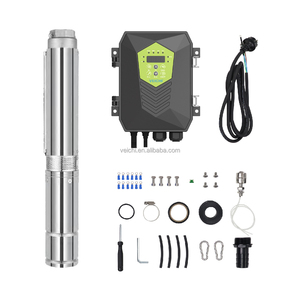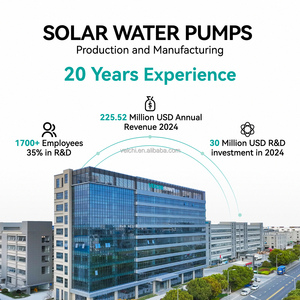
All categories
Featured selections
Trade Assurance
Buyer Central
Help Center
Get the app
Become a supplier

(282 products available)














































Submersible pumps in Australia are used for a wide array of applications. They all function by pushing rather than sucking the liquids to the surface. Below are the types to consider.
These are designed for removing water that does not contain any abrasive materials. They are good for homeowners who want to remove water from wells, cisterns, tanks, or swimming pools.
These are created to handle water with small solids or a lot of sediment. Such water is common in construction sites, flooded basements, and agricultural fields.
These types of pumps are designed to lift water from deep underground sources. They are used for drilling boreholes or for irrigation in farming. Buyers who want these options, however, should have the right electrical or power supply since these pumps often work at high voltage.
These work by automatically removing excess groundwater that collects in a sump basin found in basements or crawl spaces. They help to prevent flooding.
These are powered by solar energy. Solar panels are often combined with battery storage to pump water where there is no access to electricity. Solar panels can also be used to help in water heating for those who want to live a sustainable lifestyle.
Battery-powered submersible pumps are often used in remote areas where access to electricity is hard. They are also used as backups in case of power outages or as primary options where there is no electric supply.
These are created for particular industrial applications. Their functions include transferring chemicals, dewatering mine shafts, or keeping up with cooling water levels in large machinery. Buyers should ensure they have the right electrical or power supply since these pumps often work at high voltage.
Every option comes with unique benefits to buyers. Here are some of the key features of the submersible water pumps available in Australia.
Like most water pumps, these options are made with stainless steel to improve the toughness and longevity of the product. This also protects the pump from corrosion as it is often used in settings where it is consistently exposed to water. Stainless steel also allows for easy cleaning and maintenance due to its smooth finishes.
About 90% of all electric motors use copper as a conductor, and for good reason. Copper is an excellent conductor of electricity and gives the motor high efficiency. High-quality submersible pumps often have motors made of copper wire. This increases the durability of the motor by preventing it from overheating. This also leads to enhanced energy efficiency and better performance.
Afloat switch is included in most sump and sewage pumps. This component automatically turns the pump on or off depending on the water level. It helps to prevent dry running, which can damage the pump.
Many submersible pumps in Australia are designed to minimize the risk of clogging. This ensures reliable operation. It also reduces the need for frequent maintenance and helps to extend the lifespan of the pump. This feature is especially important when the pump is used to move dirty or debris-filled water.
These pumps have tight seals that protect the internal components from water and debris. This prevents damage and increases the longevity of the product. The seals also protect from contaminants that could potentially harm the inner workings of the pump and lead to quicker wear and tear.
Most submersible pumps deliver a high flow rate, allowing them to quickly and efficiently move large quantities of water. This makes them ideal for heavy-duty tasks such as dewatering construction sites and draining flooded basements.
These pumps can start pumping water automatically without needing to be primed manually. This saves time and makes them more convenient to use. This feature is particularly helpful when the pump needs to be used in remote locations without easy access to water.
These pumps are handy for various commercial purposes. From agriculture to construction, these pumps are suitable for various experts. Here are the common commercial use scenarios to consider.
In construction sites, they are used to remove excess groundwater and mud. This makes working conditions safer and easier. They also help prevent damage to equipment and structures by keeping the work area dry.
Farmers use these pumps for irrigation. They help deliver water to crops, ensuring they get the moisture needed for growth. This leads to better crop yields and quality. They are also a more efficient way to water large agricultural fields.
These pumps help manage flood situations by quickly draining excess water from affected areas. This reduces damage to property and infrastructure and minimizes the impact of flooding on businesses and homeowners.
They are used in commercial water features such as fountains and ponds. These pumps keep the water circulating, which improves the aesthetic appeal of the business. They are also great for maintaining a healthy environment for fish and plants.
They are used to supply water to areas without direct access to municipal water systems. They are installed in boreholes to extract and provide water for drinking, cooking, cleaning, and other daily activities in both residential and commercial settings.
In mining, these pumps are used to remove excess water from mine shafts and pits. This makes the mining process safer and more efficient. They also help prevent drowning and allow workers to operate equipment without the hindrance of water.
They are used in various industrial applications. They help in cooling machinery, which improves production processes. They are also used to remove wastewater or to provide water for certain manufacturing processes, such as in chemical production or for concrete mixing.
They are handy for use during power outages. They can automatically start when water levels rise, preventing basement flooding during blackouts. They also provide peace of mind that homes and businesses will not suffer water damage when the power goes out.
There is a subset of factors to consider when buying these pumps in bulk. Here are the factors to keep in mind when choosing the pumps.
This is the main factor to consider. There is a wide range of these pumps on the market, each suitable for different applications. For example, a deep well pump should be used if customers plan to use the pump for bore water. A solar pump will be ideal for users who have no access to an electric supply and are looking for sustainable options.
For customers who need to move clean water, they can use submersible pumps made for this purpose. However, those who need to transfer dirty or corrosive water should stock pumps capable of withstanding chemicals or large sediments. Chemical-resistant materials might be required for water with high chlorines or other chemical content.
Most of these pumps are used in remote areas where access to electricity is limited. Some are even powered by batteries to ensure they continue operating even during power outages. Buyers who want to minimize operational costs for customers should consider energy-efficient models. Models with automatic features that reduce the need for manual intervention will also help save energy.
These two are critical for determining whether the pump will fulfill a customer's needs. Flow rate refers to how much water the pump can move in a given period. The pump should be able to handle the water volume required by the customer. Customers who plan to using the pump for deep wells should get a submersible pump that offers sufficient head height.
Ensure tostock pumps made of durable materials and with high-quality components. These pumps are often exposed to harsh conditions, so the material must be of high quality and weatherproof. Also, get options that are easy to maintain. Many come with tight seals that protect the internal components from debris and contaminants.
Lastly, consider the electric supply. Many of these pumps are electric-powered. Buyers should ensure they get models that correspond to the local voltage to prevent any operational issues.
A1. No. There is a wide range of these pumps, and each is designed for different applications. For example, a deep well pump should be used if customers plan to use the pump for bore water. A solar pump will be ideal for users who have no access to electric supply and are looking for sustainable options.
A2. Common issues include clogging, overheating, and corrosion. Other problems include motor damage, electrical failure, and physical damage to the pump.
A3. Yes, clients can use them to transfer chemicals. However, they must ensure they have the right pump for this task. They might also require chemical-resistant materials for water with high chlorine or other chemical content.
A4. Buyers should prioritize factors such as the intended use, the type of fluid, and the required flow rate. Other factors include the head height, energy efficiency, and durability.
A5. Yes, they are relatively easy to install, especially when compared to other types of pumps. Many clients install them themselves because they come as self-priming and ready to use. They just need to lower the pump into the water and connect it to the power source. The installation process will, however, differ depending on the type of pump and the application it will be used for.
Submersible pumps are ideal for different applications in Australia. They also offer multiple benefits. Here are the advantages to consider when purchasing them.
The main advantage of these pumps is efficient water removal, particularly in areas flooded with water. They can pump water faster than most other types of pumps, providing quick relief in emergency situations.
These pumps are ver-sa-tile and can be used for various applications. They are especially ideal for transferring water from wells, boreholes, and underground garages. They can also water crops, irrigate gardens, and maintain fountains, among other uses.
These pumps can easily start pumping without having to be manually primed. This makes them convenient to use, especially when the conditions require them to spring into action immediately.
These pumps are built to withstand harsh conditions. They are often made from strong materials such as stainless steel, which is weatherproof and resistant to corrosion. This makes them durable and reduces the frequency of replacement for customers.
Because these pumps operate underwater, there is less likelihood of the water interacting with contaminants found on land. This ensures the water remains clean and safe for its intended uses. This is especially important for farming and drinking purposes.
Since these pumps are designed to work underwater, they tend to be more compact than other types. This makes them easy to transport and install, even in tight or hard-to-reach spaces. Customers will also be able to store them without taking much space.
These pumps are designed to be energy efficient, especially the ones powered by solar energy or batteries. This helps keep operational costs low, which is great for customers intending to use the pump long-term. Many of these pumps are also designed for easy maintenance, which helps keep costs down over time.
Many of these pumps are self-priming, meaning they can be quickly installed by simply submerging them in the water and connecting them to a power source. This allows for fast deployment when time is of the essence. They can also be installed in deep wells or boreholes, depending on the model. They are designed to handle high pressure.